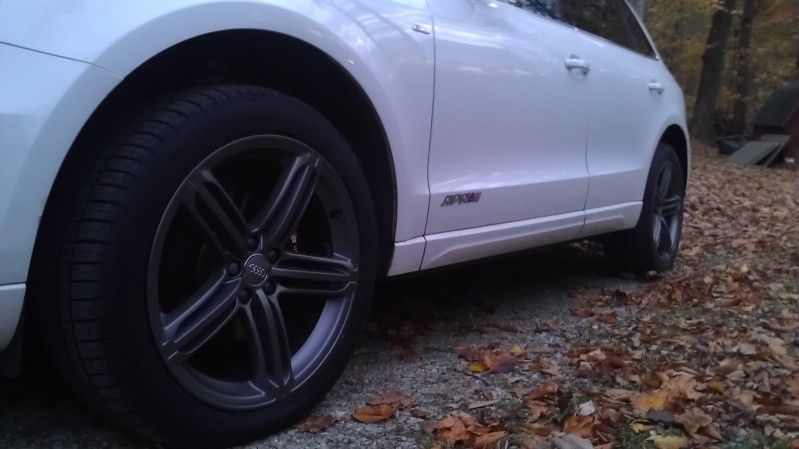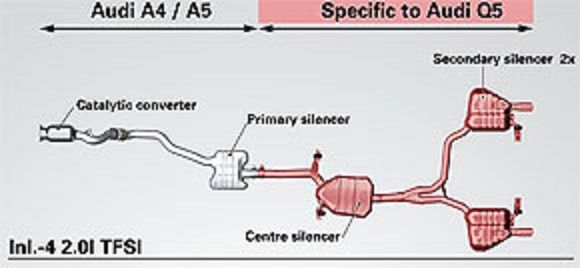Hi All. EuroTech’s the group that just finished my Q5, as described above. I had posted some comments earlier, but took them down for revision. I am not a regular poster. I’m an avid reader here and at AudiWorld and at other Audi and Porsche sites, and a long-term car enthusiast who’s had a very eclectic mix of entertaining vehicles over the years, some very fast, others more suited to attracting the opposite sex.
This is a long post but I hope informative. For those looking for part numbers or links, just email me and I'll provide them if I can, and can find the time.
When I met Danek and the guys at EuroTech Motorsports I knew right away they'd do the kind of build I had in mind, and be forthright about providing me good recommendations based on experience of what works and not just what looks "trick" or "blingy." I never go off road with the Q5. That is why there are Jeeps.
I'll describe what I can about the superb result EuroTech achieved (with expert help from Ryan at APR and Alex at Europrice), but first my thoughts about what is reasonable to expect from a Q5.
The Q5 is an SUV, albeit a small one. It has and will always have a high center of gravity and fairly front-biased weight distribution. That said the 2.0T has much better weight distribution than the 3.2 V6 as well as the arriving 2013 3.0 supercharged variant. A stock 2011 2.0T Premium Plus weighs 4,090 lbs, a 2011 3.2 V6 PP weighs 4,299 lbs and the 2013 3.0 V6 PP weighs 4,354 lbs. I don't know if these weights are with or without lubricants and gas.
As such, absolutely no matter what you do to it, the Q5 will never behave like a mid-engine sports car with 1-1/2" of ground clearance, 50%-50% F/R weight distribution, and all kinds of undercarriage and other aero aids. I'm not even sure if the Q5 has an aerodynamic center of pressure although I guess it must.
But you can have fun with the Q5, and make it better in all performance respects than when it left Ingolstadt, without sacrificing comfort, ride quality, quietness or luxury.
Power
Getting extra power is a relatively easy, if not inexpensive proposition with the 2.0T FSI motor. If one does not intend to do track days or race the Q5 (and I'm not sure why anyone would want to race one), no internal beefing-up of con-rods, shaft bearings, valve train, oiling, etc, is needed to safely approach 200 bhp per liter, even without higher-flow injectors, monster fuel pumps or silly coil packs. All you need is good 100-octane gas, some wizardry from APR, and better breathing. There are two version of the ZF 8-speed torque-converter automatic transmission, one good for around 500 LbFt and the other good for nearly 1,000 LbFt. The 2.0T uses the lesser of the two, so there's no reason to be concerned you're going to shatter the tranny. By the way, this is simply the best torque-converter tranny I have ever experienced, despite a lot of nonsense I’ve read about jerky downshifting. In M-mode it’s better than many early-generation PDKs or DSGs. Try back parking with an early PDK in Auto mode if you want to experience herky-jerky shifting and bumper damage.
To achieve power outputs in the range I’ve mentioned the motor has to breathe cold, dense air very, very well and get rid of combustion gasses equally efficiently after extracting the energy latent in them. On the stock 2.0T the significant restrictions to these two objectives are:
• The intercooler. It’s small, has relatively-high internal air temperatures, its plumbing is convoluted, it has excessive, restrictive sound attenuation, it has pretty-poor pressure drop and turbulence, and slow-as-molasses temperature recovery.
• The size and reaction time of the turbo and its fittings.
• The needlessly-small catalytic converter.
Believe it or not, from the cat back the stock exhaust is just fine with the kind of output I'm mentioning and it’s stainless steel to boot, so fiddling with it for another $1,200 gets you little added power and just more HNV. Likewise the fresh air intake to the turbo. The stock unit already uses a ram-air design and again, even if Carbonio made one that fit the Q5, your $600 gets you almost nothing. Stick with the stock until something with a better price/performance ratio comes along. The Carbonio unit is a bling item, and if bling’s your thing, be my guest.
Since EuroTech didn’t include photos of the two first-phase items for the Q5 build, here they are. The quality of both is much superior to the OEM items, and the fitment was perfect without any glitches, including the bungs for the O2 sensors. I would possibly recommend some kind of expanded-wire honeycomb mesh behind the front grille to protect the FMIC since it does hang down much lower that the stock unit and is not particularly well-protected from road debris.
Eurocode Tuning FMIC (Mandrel bent, 2.5" aluminum hard piping comes in black powder coat too, which is what I got):

Eurocode Tuning Hi-Flow Cat:

These two items and the first tune that EuroTech developed with APR totally transformed the power output. With 100-octane gas the Q5 easily sailed past its former artificially-limited top speed (on a closed course). I did not go faster than that because the stock tires are not rated for such speeds. Torque came on at about the same RPM, but rose much faster to a higher, very-flat peak. Power and torque started to diminish at about 5,750 rpm. Definitely much faster to 100 kph, but no objective timing was done.
Now that motor modifications are complete with the other items that EuroTech described and APR has customized a tune to the equipment specifications, I will be doing a series of dyno tests (over several days and at differing thermal loads) to ascertain objectively the approximate whp and wtq this Q5 makes.
I will buy an APR badge for the poster that comes the closest to predicting the average tested values. That said, I’m still “bedding in” the brakes and turbo, so have not really opened it up yet. But I can tell you that it is ferocious starting at about 1,300 rpm in M2, and I was only at three-quarters not WOT. A lot of this has to do with the superb Quattro system being able to get so much of the power to the pavement without wasting it in wheel spin.
Brakes
Ettore Bugatti said he made his cars to go and not to stop, hence their reputation for shit-your-pants scary brakes. All of the aftermarket guys like StopTech, Brembo, Movit, AP (which STaSIS rebadges) and others, are hampered in their Audi offerings because of Audi’s current electronic rear e-brake system. None have rear brakes kits to provide a balanced four-wheel system. Movit is supposed to be making a rear system soon with a second e-brake-only caliper for each rotor that is actuated by a remote “master” cylinder pressurized by an electric solenoid operated by the stock Audi electronic e-brake system. Sounds inexpensive, doesn’t it?
So, in the end, Alex at Europrice had what seemed to me the most elegant, relatively affordable and strictly OEM solution: use the complete front and rear systems from the 2013 Audi RS4 Avant. All parts are direct bolt on including the splash guards. All the hard brake lines on the body are in the right locations, and the new calipers come with stock new flexible lines. A note on flexible brake lines: for Audis at least, save your money and don’t buy stainless-steel flexible lines. The stock Audi lines are Kevlar reinforced and distend less under pressure than stainless lines. Stainless steel lines are just another example of bling that does nothing and costs more. The RS4 Avant system uses Brembo-sourced 8-pot four pad front calipers, with 4-pot two-pad rears. As I said, they’re not bedded in yet, but I bet I’ll be able to remove fillings from my teeth under full deceleration. The Michelin Pilot Super Sport tires also contribute mightily to the better braking. The Q5 originally came with the optional 19" OEM five-spoke wheels (8,0Jx19H2 ET39, P/N 8R0.601.025.J) and these do fit over the RS4 Avant brakes. These will now be my winter wheels with winter tires.
Handling
I grew up with cars that tended to oversteer either on purpose or, in the case of some very early 911 Porsches, unintentionally and very dramatically under trailing throttle. So I like an amount of oversteer that I can modulate as needed with the throttle or steering or both. Because it’s what most mass-market manufacturers do today, the Q5 is designed with moderate understeer as it approaches corning limits, and becomes nearly neutral when gently lifting the throttle or braking delicately, or steering more in the direction of travel. It also has fairly pronounced roll due to its suspension height, but is very predictable and confidence-inspiring once it’s done rolling and takes a set. And of course it has all kinds of electronics to keep you out of the weeds.
My goals for handling were, not necessarily in this order, to add slight oversteer (or reduce inherent understeer) that I could modulate with the throttle, to increase roll stiffness, to improve the crispness of turn-in, and to increase overall cornering limits. All without sacrificing comfort, ride quality and quietness, or adding harshness and roughness on imperfect road surfaces. Piece of cake, right?
I had been considering varying the size of anti-roll bars, changing bushing types, using Heim joints where possible, and adding adjustable control arm links and camber and caster upper strut mounting plates. Plus using some combination of adjustable coil overs. Here's where Danek looked me in the eye and said what I was thinking is overkill for a road car. He said just go with the Audi OEM 8,5Jx20H2 ET33 titanium-finish triple-five spoke wheels with Michelin Pilot Super Sport 255/45 R 20s along with the KW Coilover Kit V1. The KW shocks in the V1 kit have preset damping, but are height adjustable down from 1.6" to 3.1" at the front and from 1.8" to 3.3" at the back. After letting the suspension settle for two days, EuroTech adjusted height for about 1" down at all four corners and had a full alignment done. On a closed-to-traffic, right-hand high-speed increasing-radius corner with a single well-defined apex that I know well, I find I am very pleased with the results (traction control obviously off). Roll stiffness is much increased and adhesion and turn-in from the Michelins is light years ahead of the all-season Goodyears that came with the car. The KWs and lowering allow very predictable, mild trailing-throttle oversteer if that’s your preferred approach in a particular corner. The much more substantial power available allows for the same oversteer effect using torque and some opposite-yaw steering. I think the Q5 prefers the former trailing-throttle approach, since the higher center of gravity makes for a bit a drama in the power-oversteer scenario. The KW V1s feel taught but not harsh around town: well snubbed. EuroTech met my handling goals perfectly.
Driver Controls
Just had to have the paddle-shifter steering wheel. Regular four-spoke so that I could reuse the air bag from my OEM wheel. Much quicker actuation of the 8-speed auto.
The Overall Exterior Look
Just want to keep it looking stock, which I think is a remarkably refined form much better realized than the rather obese Q7. The Q5’s design is successful the way the A5 is in respect to the A4. With the exception of the wheels and brakes, which only those in the know would recognize, it’s as it came from the factory on the outside and I intend to keep it that way. It is after all a Q-ship.




























































Bookmarks